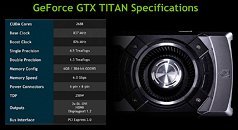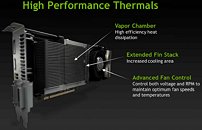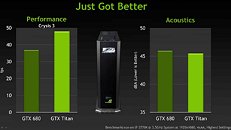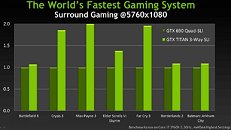- Joined
- Oct 9, 2007
- Messages
- 47,243 (7.55/day)
- Location
- Hyderabad, India
| System Name | RBMK-1000 |
|---|---|
| Processor | AMD Ryzen 7 5700G |
| Motherboard | ASUS ROG Strix B450-E Gaming |
| Cooling | DeepCool Gammax L240 V2 |
| Memory | 2x 8GB G.Skill Sniper X |
| Video Card(s) | Palit GeForce RTX 2080 SUPER GameRock |
| Storage | Western Digital Black NVMe 512GB |
| Display(s) | BenQ 1440p 60 Hz 27-inch |
| Case | Corsair Carbide 100R |
| Audio Device(s) | ASUS SupremeFX S1220A |
| Power Supply | Cooler Master MWE Gold 650W |
| Mouse | ASUS ROG Strix Impact |
| Keyboard | Gamdias Hermes E2 |
| Software | Windows 11 Pro |
Specifications of NVIDIA's upcoming high-end graphics card, the GeForce GTX Titan, which were reported in the press over the last couple of weeks, are bang on target, according to a specs sheet leaked by 3DCenter.org, which is allegedly part of the card's press-deck. According to the specs sheet, the GTX Titan indeed features 2,688 out of the 2,880 CUDA cores present on the GK110 silicon, 6 GB of GDDR5 memory across a 384-bit wide memory interface, and draws power from a combination of 6-pin and 8-pin PCIe power connectors.
The GeForce GTX Titan core is clocked at 837 MHz, with a GPU Boost frequency of 876 MHz, and 6.00 GHz memory, churning out 288 GB/s of memory bandwidth. The chip features a single-precision floating-point performance figure of 4.5 TFLOP/s, and 1.3 TFLOP/s double-precision. Despite its hefty specs that include a 7.1 billion-transistor ASIC and 24 GDDR5 memory chips, NVIDIA rates the card's TDP at just 250W.

More slides and benchmark figures follow.
The next slide leaked by the source reveals key features of the reference design cooling solution, which uses a large lateral blower that features RPM and voltage-based speed control on the software side, a vapor-chamber plate that draws heat from the GPU, memory, and VRM; and an extended aluminum fin stack that increases surface area of dissipation.

Next up, we have performance numbers by NVIDIA. In the first slide, we see the GTX Titan pitted against the GTX 680, in Crysis 3. The GTX Titan is shown to deliver about 29 percent higher frame-rates, while being a tiny bit quieter than the GTX 680.
In the second slide, we see three GeForce GTX Titans (3-way SLI) pitted against a pair of GeForce GTX 690 dual-GPU cards (quad-SLI). In every test, the Titan trio is shown to be faster than GTX 690 Quad-SLI. In Crysis 3, GTX Titan 3-way SLI is shown to be about 75 percent faster; 100 percent faster in Max Payne 3, 40 percent faster in TESV: Skyrim, and 95 percent faster in Far Cry 3. Why this comparison matters for NVIDIA is that if Titan does end up being a $1000 product, NVIDIA will have to sell three of them while offering something significantly better than GTX 690 quad-SLI.


View at TechPowerUp Main Site
The GeForce GTX Titan core is clocked at 837 MHz, with a GPU Boost frequency of 876 MHz, and 6.00 GHz memory, churning out 288 GB/s of memory bandwidth. The chip features a single-precision floating-point performance figure of 4.5 TFLOP/s, and 1.3 TFLOP/s double-precision. Despite its hefty specs that include a 7.1 billion-transistor ASIC and 24 GDDR5 memory chips, NVIDIA rates the card's TDP at just 250W.

More slides and benchmark figures follow.
The next slide leaked by the source reveals key features of the reference design cooling solution, which uses a large lateral blower that features RPM and voltage-based speed control on the software side, a vapor-chamber plate that draws heat from the GPU, memory, and VRM; and an extended aluminum fin stack that increases surface area of dissipation.

Next up, we have performance numbers by NVIDIA. In the first slide, we see the GTX Titan pitted against the GTX 680, in Crysis 3. The GTX Titan is shown to deliver about 29 percent higher frame-rates, while being a tiny bit quieter than the GTX 680.
In the second slide, we see three GeForce GTX Titans (3-way SLI) pitted against a pair of GeForce GTX 690 dual-GPU cards (quad-SLI). In every test, the Titan trio is shown to be faster than GTX 690 Quad-SLI. In Crysis 3, GTX Titan 3-way SLI is shown to be about 75 percent faster; 100 percent faster in Max Payne 3, 40 percent faster in TESV: Skyrim, and 95 percent faster in Far Cry 3. Why this comparison matters for NVIDIA is that if Titan does end up being a $1000 product, NVIDIA will have to sell three of them while offering something significantly better than GTX 690 quad-SLI.


View at TechPowerUp Main Site











